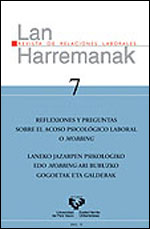Acción sindical ante el acoso moral en el trabajo
##plugins.themes.bootstrap3.article.main##
##plugins.themes.bootstrap3.article.sidebar##
Abstract
The breeding ground for moral harassment at work does not lie in the personality of the harasser or the harassed, but in the form of work organization and the strategies for poor working conditions, in the formulas for the resolution of conflicts and the prevailing styles of command. The difficulties for union action are caused by a narrow vision of union activity concerning work health, limited to the prevention of accidents, by the idea that harassment belongs to the field of personal relations, which, as union representatives, we should not enter into, by the difficulty in proving the situations of harassment, by the influence of the rumours generated by the harassers and by the existence of non-exemplary previous behaviour on the part of those who are harassed. Union activity should combine support for the victims with general information work, the identification of the factors which facilitate harassment, the preventive measures to be applied and a collective negotiation to obtain commitment from the management, a training plan and an efficient procedure for the processing of the accusations which arise.
How to Cite
##plugins.themes.bootstrap3.article.details##
Authors who publish in the journal "Lan Harremanak" do so in agreement with the following terms:
1. Authors retain the copyright of their papers. while ceding to the journal "Lan Harremanak" the right to the first publication of their article.
2. The publisher UPV/EHU Press is a joint copyright holder, in order to protect the legitimate use of the published paper and compliance with CC terms.
3. Published papers are subject to a Creative Commons CC-BY license (unless stated otherwise) which permits third parties to share the paper, on the condition that the author and source are specified when material is reproduced.
4. Authors can enter into other non-exclusive license agreements regarding the published version of their work (e.g. depositing it in an institutional repository or re-publishing it as a monographic volume), providing the author and source are given appropriate credit.
5. Dissemination of submitted articles via Internet is both allowed and recommended (e.g. in institutional repositories and/or on the researcher's web page), both before and during the process of submission, since this can lead to interesting dialogues and also increase citations to the eventual publication.

